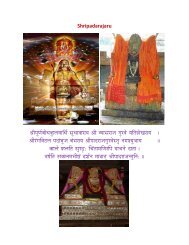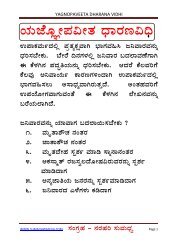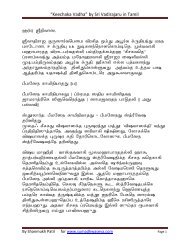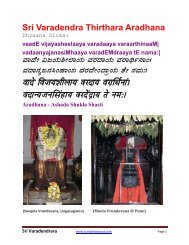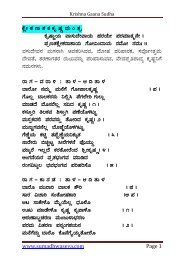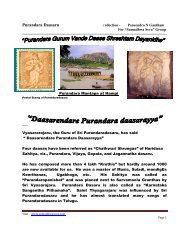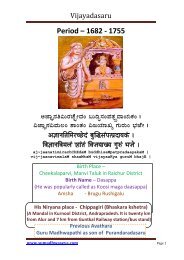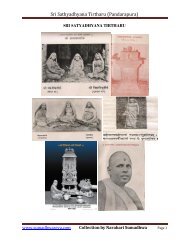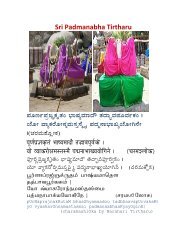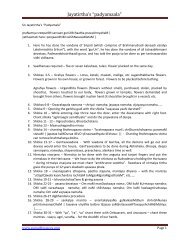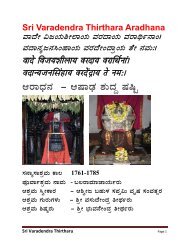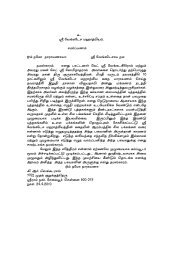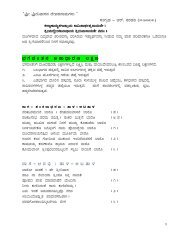Sri Jayatirtha's Moola Vrundavana @ Malakheda - Sumadhwa Seva
Sri Jayatirtha's Moola Vrundavana @ Malakheda - Sumadhwa Seva
Sri Jayatirtha's Moola Vrundavana @ Malakheda - Sumadhwa Seva
You also want an ePaper? Increase the reach of your titles
YUMPU automatically turns print PDFs into web optimized ePapers that Google loves.
<strong>Sri</strong> Jayatirtha’s <strong>Moola</strong> <strong>Vrundavana</strong> @ <strong>Malakheda</strong><strong>Sri</strong> Vadiraja Tirtharu called these jnaanees as “diggajaas”i.e., the yathees who are eight in number (during his visittime, there were only 8 vrundavanaas).Let us analyse the period of <strong>Sri</strong> Vadiraja Tirtha’s visit toAnegondi based on various articles –a. As per <strong>Sri</strong> Chikkeruru Govindacharya - 1550– 1565b. As per <strong>Sri</strong> T K Venugopaladasaru - 1583 – 1588c. As per Kustagi Krishnamurthi – even when <strong>Sri</strong> Vyasarajaruwas alive, Vadirajaru had done the Tirthayatred. As per Korate <strong>Sri</strong>nivasarao it is 1520 – 1535e. As per Sanuru Bheemabhattaru’s third edition of anuvadaof Tirthaprabandha – Out of Diggajaas there may be somewho had entered <strong>Vrundavana</strong> after the <strong>Vrundavana</strong> praveshaof Vadirajaru.All of them have given the dates to match theiranalysis. None have given sufficient proof.²æà dAiÀÄwÃxÀðgÀ ªÀÄÆ® ªÀÈAzÁªÀ£À EgÀĪÀÅzÀÄ £ÀªÀªÀÈAzÁªÀ£ÀUÀqÉØAiÀÄ°è C®èJA§ÄzÀÄ ¥Àæw±ÀvÀ 100/100gÀµÀÄÖ ¸ÀvÀåªÁzÀ «µÀAiÀÄ. PÁgÀt - AiÀiÁªÀÅzÉÃC¥ÀgÉÆÃPÀë eÁÕ¤UÀ¼ÀÄ ²æà dAiÀÄwÃxÀðgÀÄ ªÀļÀSÉÃqÀzÀ°è E®èªÉAzÀÄ ¸ÉÆÛÃvÀæªÀiÁr®è. J®è C¥ÀgÉÆÃPÀë eÁÕ¤UÀ¼ÀÆ CªÀgÀ£ÀÄß ªÀļÀSÉÃqÀzÀ¯Éèà ¸ÀÄÛw¹zÁÝgÉ.DzÀÝjAzÀ ²æÃdAiÀÄwÃxÀðgÀÄ ªÀļÀSÉÃqÀzÀ¯Éèà EgÀĪÀÅzÀÄ JA§ÄzÀÄ ¸ÀĸÀàµÀ×. ²æÃdAiÀÄwÃxÀðgÀÄ £ÀªÀªÀÈAzÁªÀ£ÀzÀ°è E®èªÉA§ÄzÀPÀÆÌ ªÀÄvÀÄÛ CªÀjgÀĪÀÅzÀĪÀļÀSÉÃqÀzÀ¯Éèà CµÉÖà C®èzÉ ¥ÀæwAiÉÆAzÀÄ ªÀiÁzsÀåAiÀÄwUÀ¼À ¸À¤ßzsÁ£ÀzÀ®Æè CªÀgÀ¸Á¤ßzsÀå«gÀĪÀÅzÀÆ PÀÆqÀ ¸ÀĸÀàµÀ×. PÉ®ªÀgÀÄ vÀªÀÄä C£ÀĪÀiÁ£ÀªÀ£ÀÄߣÀªÀªÀÈAzÁªÀ£ÀzÀ¯Éèà EgÀĪÀgÉAzÀÄ ¨sÁ«¹ §gÉ¢gÀĪÀ ¥ÀvÀæPÉÌ GvÀÛgÀ E°èzÉ –We have furnished herebelow,some documents/ proofs forsaying <strong>Sri</strong> Jayatirtha’s <strong>Vrundavana</strong> is not inNavavrundavana –1. <strong>Sri</strong> Narayana Tirtha, the direct shishya of Vyasarajaru, anda close friend of <strong>Sri</strong> Vadirajaru, and the samsthanadhipathiof Koodli Akshobhya Tirtha Mutt has written in 1467ADitself that <strong>Sri</strong> Jayatirtha’s and <strong>Sri</strong> Akshobhya Tirtha’s<strong>Vrundavana</strong> is at <strong>Malakheda</strong> itself.www.sumadhwaseva.com By Narahari <strong>Sumadhwa</strong> Page 3
<strong>Sri</strong> Jayatirtha’s <strong>Moola</strong> <strong>Vrundavana</strong> @ <strong>Malakheda</strong>2. <strong>Sri</strong> Vadiraja Tirtharu has not written the Tirtha prabhandhain that particular place itself. He must have writtenafter completing his tour.3. <strong>Sri</strong> H K Vedavyasacharya in his grantha, “Gurucharite”, written in 1949AD –page no 106 which is recognized as the official records of Rayara Mutt says that<strong>Sri</strong> Jayatheertharu entered vrundavana at <strong>Malakheda</strong> on Ashada Krishnapanchami day of 1388AD.4. Gurucharite, from Rayara Mutt – latest edition released in 2010 also confirms thatthe <strong>Vrundavana</strong> is in <strong>Malakheda</strong>5. <strong>Sri</strong> Raja Gururajachar in his “Ajayya Vijayeendraru” has also opined in favour of<strong>Malakheda</strong>.6. <strong>Sri</strong> Raja Gururajachar in his article in Parimala in 1962 January issue has writtenthe same while writing an article on “<strong>Sri</strong> Gurubhakta Bheemadasaru”.7. Parimala Magazine 1968 July edition in the article “<strong>Sri</strong> Jayatirtha Vijaya” hasmentioned that “<strong>Sri</strong> Jayateertharu entered vrundavana in the sannidhana of hisguru Akshobhya Tirtharu”.8. <strong>Sri</strong> T K Venugopaladasaru in his article in Parimala 1977August issue has said that <strong>Sri</strong> Jayatirtha’s <strong>Vrundavana</strong> isat <strong>Malakheda</strong>.9. <strong>Sri</strong> T K Venugopaladasaru in his book “<strong>Sri</strong> Jayatirtha’s moolavrundavana” titledbook had removed the name of <strong>Sri</strong> Raghuvarya Tirtharu and replaced his namewith <strong>Sri</strong> Jayatirtharu at Navavrundavana. But the University of Mysore refused toaccept the quoting of T K Venugopaladasaru. This also confirms that <strong>Sri</strong>Jayatirtha’s <strong>Vrundavana</strong> is not at Navavrundavana and it is at <strong>Malakheda</strong> only.10. <strong>Sri</strong> Jagannatha Dasaru in his “Navavrundavana poem” has listed the nine yatheesnames, wherein he has mentioned Padmanabha, Kavindra, Vageesha, Vyasaraya,Raghuvarya, Sudheendra, Govinda Odeya, <strong>Sri</strong>nivasa Tirtha, Ramatirtha. He hasnot mentioned anything about Jayatirtharu at Navavrundavana.11. None of the Mutts have done the aradhana of <strong>Sri</strong> Jayatirtharu at Navavrundavana.Ofcourse all other yathees aradhana is being done at Anegondi. When everysaint’s aradhana is being done at Anegondi, why not Jayatirtha’s aradhana? Thisalso proves non existence of Jayatirtharu at Anegondi.www.sumadhwaseva.com By Narahari <strong>Sumadhwa</strong> Page 4
<strong>Sri</strong> Jayatirtha’s <strong>Moola</strong> <strong>Vrundavana</strong> @ <strong>Malakheda</strong>12. While praising the other yathees in Navavrundavana, thereis no mention about any yathi that “he is staying in the<strong>Sri</strong> Jayatirtha’s <strong>Vrundavana</strong> Sannidhana”.13. <strong>Sri</strong> T K Venugopala dasaru in his book “<strong>Sri</strong>majjayatirtha’smoolavrundavana” has said that <strong>Sri</strong> Krishnadevaraya haspraised Jayatirtharu in his Rajatha Shasana as follows –"¥ÀÄ°N¯ï UÀĺÉAiÀÄ°zÀÄð UÉ°zÉ «zÁågÀtågÀAJAvÀÄAmÉÆà ªÉÊAiÀiÁPÀgÀt ¥Àæw¨sÁ ¤£Àß°è |¨sÀÄdAUÀ£Á®AiÀÄzÀ°è UÀdUÉÆAzÀ®¢ ¤AzÉdAiÀÄgÁAiÀÄ JAvÀÄAmÉÆà ¤£Àß°è £ÀAzÀwÃxÀðgÀ ªÉÆúÀ"As such, <strong>Sri</strong> Jayatirtha’s <strong>Vrundavana</strong> is at Navavrundavana as per TKVenugopaladasaru. But it can’t be accepted as analysed herebelow :a. But in the said poem, there is no alliteration (“praasa”)at all. This is written in Halegannada (old kannada), itmeans that it is not written by Krishnadevaraya. He was apandit himself in both Kannada and Telugu. When <strong>Sri</strong><strong>Sri</strong>kantacharya has met those who have referred the abovestanza, they could not give any satisfactory informationabout the shaasana.b. In the poem there is no information about the vrundavanaat all. “bhujanganaalayadalli” means ant hill (ºÁ«£À ºÀÄvÀÛ).As such, it may be guessed that <strong>Sri</strong> Jayatirtharu isstaying in Gajagahvara’s ant hill in the disguise of asnake.c. Prof <strong>Sri</strong> <strong>Sri</strong>nivasa Ritti, of Karnataka University University, who wasProfessor of Ancient Indian History says –i. Krishnadevaraya has not written any shaasana himself.ii. The poem is written by an ordinary poet.iii. The said shaasana isn’t in proper style.14. <strong>Sri</strong> Korate <strong>Sri</strong>nivasa Rao in his book titled “<strong>Sri</strong>Jayatirtharu” released in 1978 and its subsequent editionin 2003 has mentined that the <strong>Vrundavana</strong> is at <strong>Malakheda</strong> orMaanyakheda.15. <strong>Sri</strong> Balagaru <strong>Sri</strong>nivasacharyaru in his introduction introduction to the bookwritten by <strong>Sri</strong> Chikkerooru Mukkundi <strong>Sri</strong>kantacharya titled“<strong>Sri</strong>mattikaakrutpadara moola vrundavana” has mentined “ <strong>Sri</strong> PadmanabhaTirtha’s aradhana is being done from hundreds of years at Navavrundavana. Whynot the aradhana of Jayatirtharu at Navavrundavana. But it is never done atwww.sumadhwaseva.com By Narahari <strong>Sumadhwa</strong> Page 5
<strong>Sri</strong> Jayatirtha’s <strong>Moola</strong> <strong>Vrundavana</strong> @ <strong>Malakheda</strong>maLaKEDadi satataa |vaasipa paavina teredoL praKyaataa |4. <strong>Sri</strong> Varadesha Vittalaru (1885-1918)AiÀÄwPÀÄ® ªÀÄÄPÀÄl ²æà dAiÀÄwÃxÀð - ........" ¤®AiÀÄ ªÀļÀSÉÃqÀ" "PÁVtÂÃwÃgÀªÁ¸À vÁ¥ÀvÀæAiÀÄ zÀÆgÀ"yatikula mukuTa shrI jayatIrtha - ........"nilaya maLaKEDa" "kaagiNItIravaasa taapatraya dUra"5. <strong>Sri</strong> Koprada dasaru (1896-1979) has written –"ªÀļÀSÉÃqÁRå ¸ÀĪÀÄA¢gÀUÉ | E¼É¸ÀÄgÀ ¸ÉëvÀ ZÀgÀt¤UÉ |E¼ÉAiÉƼÀÄ PÁ¥ÀðgÀ ¤®AiÀÄ£À ºÀjAiÀÄ |M®ÄªÉÄAiÀÄ ¥ÀqÉzÀ AiÀÄwÃAzÀæ¤UÉ| ªÀÄAUÀ¼ÀA dAiÀÄ ªÀÄAUÀ¼ÀA..."maLaKEDaaKya sumaMdirage |iLesura sEvita charaNanige |iLeyoLu kaarpara nilayana hariya |olumeya paDeda yatIMdranige|maMgaLaM jaya maMgaLaM...6. Kannada poet Toraviya Narahari in his Kannada Jayatirtha VijayaªÀļÀSÉÃqÀzÉƼÀÄ §AzÀÄ vÉÆgÀ« £ÀgÀºÀj ¥ÁzÀUÀ¼À ¸Àäj¹ªÀÈAzÁªÀ£À PÉÆAqÀ gÁAiÀÄjUÉ.....maLaKEDadoLu baMdu toravi narahari paadagaLa smarisivRuMdaavana koMDa raayarige.....7. Raghavendrappa, a poet who wrote Saraswata parinaya, who is fromShashtika vamsha, has said <strong>Sri</strong> Jayatirtha & Akshobhya Tirtha’s vrundavana isat <strong>Malakheda</strong>.8. <strong>Sri</strong> Prasanna <strong>Sri</strong>nivasadasaru in his “<strong>Sri</strong> Jayatirtha Vijaya” keerthana has saidthat <strong>Sri</strong> Jayatirtharu entered in his gurukshetra <strong>Malakheda</strong>.maLaKEDa kShetradalli kaagini nadi tIra……. akShObhyara vRundaavana… Jayaraaya alliyE nintaru….<strong>Vrundavana</strong>dalli”9. In his Kruti “<strong>Sri</strong>majjayaarya nama:” – sri TandeVenkatesha Vittala has saidzsÀgÉAiÉƽzÀÝ wÃxÀðPÉëÃvÀæUÀ¼À£Éß®è ZÀj¹ ªÀÄvÀ ¸ÁªÀiÁædå ºÀgÀ»... AiÀÄgÀUÉÆüÀzÀ°vÀ¥ÀªÁZÀj¹ C£ÀAvÀgÀ¢ UÀÄgÀÄUÀ¼À ¸À«ÄÃ¥ÀªÀ£ÀÄ ¸Áj ªÀļÀSÉÃqÀzÀ° ªÀgÀ «¨sÀªÀ DµÁqÀPÀȵÀÚ ¥ÀAZÀ«Ä PÀ¼ÉçgÀªÀ¤lÖ"www.sumadhwaseva.com By Narahari <strong>Sumadhwa</strong> Page 9
<strong>Sri</strong> Jayatirtha’s <strong>Moola</strong> <strong>Vrundavana</strong> @ <strong>Malakheda</strong>kÉUãrÉÉãÍVû¬ iÉÏjÉï¤Éå§ÉaÉVû³ÉãssÉ cÉËUÍxÉ qÉiÉ xÉÉqÉëÉerÉ WûUÌWû... rÉUaÉÉåVûSÍsÉiÉmÉuÉÉcÉËUÍxÉ AlÉÇiÉUÌS aÉÑÂaÉVû xÉqÉÏmÉuÉlÉÑ xÉÉËU qÉVûZÉåQûSÍsÉ uÉU ÌuÉpÉuÉ AÉwÉÉQûM×üwhÉ mÉÇcÉÍqÉ MüVåûoÉUuÉÌlÉ–û"10. <strong>Sri</strong> Uragaadri Vyaasavittalaru in his kruti has said–"eÉrÉiÉÏjÉï qÉÑÌlÉuÉrÉï SrÉãiÉÉåËU mÉÉãUãrÉrrÉ""CVãûrÉÉãVûaÉã ÌlɳÉÇiÉWû MüÂhÉÉÍVûaÉVû MüÉhÉã...qÉVûZÉåQû ÌlÉuÉÉxÉ rÉÌiÉMÑüsÉkÉÏzÉ..""dAiÀÄwÃxÀð ªÀÄĤªÀAiÀÄð zÀAiÉÄvÉÆÃj ¥ÉÆgÉAiÀÄAiÀÄå""E¼ÉAiÉƼÀUÉ ¤£ÀßAvÀºÀ PÀgÀÄuÁ½UÀ¼À PÁuÉ...ªÀļÀSÉÃqÀ ¤ªÁ¸À AiÀÄwPÀÄ®¢üñÀ.."11. <strong>Sri</strong> Guru Govinda Vittala Dasaru in his kruti has said –gÀxÀªÉÃj §gÀÄwºÀ UÀÄgÀĪÀgÀ£ÁågÉ ¥ÉüÀªÀÄäAiÀÄå................................¨sÀÆ«ÄeÁªÀgÀ ²æÃgÁªÀÄ¥ÀzÁZÀðPÀ ²æêÀļÀSÉÃqÀ ¸ÀÄzsÁªÀÄ PÀtªÀÄä" |4 |12. <strong>Sri</strong> Guru Govinda Vittala Dasaru in another of hiskrutiVaadivadana kumuda soorya……….tIrthakshetragala sancharisi –jayatIrtha kaagini taTadi nelesi13. <strong>Sri</strong> Ballatagi Gundacharya with ankita “<strong>Sri</strong> Shyama sundara” wrote in“dayadi salaho jayaraaya”…..kaagini nilaya kavijanageya PÁV¤ ¤®AiÀÄ PÀ«d£ÀUÉÃAiÀÄYogivariya krupasaagara satataa |14. <strong>Sri</strong> H Bheemarayaru with “<strong>Sri</strong>krishna vittala ankita” said in his“nimbi bajisiro…. Namma jayaraayara”………….. “malaKEDadhI – nelasi ipparU ªÀÄ®SÉÃqÀ¢üà £É®¹ E¥ÀàgÀÆnaLinanaabhanaa – olisutanudinaa”.In most of the devaranamaas, not only <strong>Malakheda</strong> name is available, but alsoKagini river name is also mentioned. No where there is mention that it is nearTungabhadra river. There are so many such evidences.Raghavendrappa, a poet who wrote Saraswata parinaya, who is from Shashtikavamsha, has said <strong>Sri</strong> Jayatirtha & Akshobhya Tirtha’s vrundavana is at <strong>Malakheda</strong>.www.sumadhwaseva.com By Narahari <strong>Sumadhwa</strong> Page 10
<strong>Sri</strong> Jayatirtha’s <strong>Moola</strong> <strong>Vrundavana</strong> @ <strong>Malakheda</strong>29. One of the historians <strong>Sri</strong> Kasagaru Madhava rayaru in his book “Arya AkshobhyaTirtha samstaha” has said in his page no 41 “<strong>Malakheda</strong>’s vrundavana”, whilelisting the <strong>Malakheda</strong> <strong>Vrundavana</strong>s has mentioned <strong>Sri</strong> Akshobhya Tirtharu and<strong>Sri</strong> Jayatirtharu’s <strong>Vrundavana</strong>.30. Some people have spread like this - 1850gÀªÀgÉUÉ ªÀiÁ£ÀåSÉÃlJAzÀÄ PÀgÉAiÀÄ®àqÀÄwÛzÀÝ ¸ÀܼÀªÀ£ÀÄß Qæ.±À.1850gÀ £ÀAvÀgÀ ªÀļÀSÉÃqÀ JAzÀÄPÀgÉAiÀÄ®àqÀÄwÛzÉ. EwºÁ¸ÀªÀ£ÀÄß vÉUÉzÀÄ £ÉÆÃrzÀgÉ F PÀÄjvÀÄ ºÉaÑ£À «µÀAiÀÄUÀ¼À£ÀÄßw½zÀÄPÉƼÀÀÄzÀÄ.GvÀÛgÀ - ªÀÈÖSÉÃl JA§ÄzÀÄ PÀ£ÀßqÀzÀ ªÀļÀSÉÃqÀ JA§ ¸ÀA¸ÀÌöÈvÀ gÀÆ¥À.ªÀiÁ£ÀåSÉÃl ¥ÁæaãÀ EwºÁ¸À ºÉÆA¢gÀĪÀ HgÀÄ. "SÉÃl" JAzÀgÉ ºÀ½î, MAzÀÄPÁ®zÀ°è EzÀÄ gÁµÀÖçPÀÆlgÀ gÁdzsÁ¤AiÀiÁVvÀÄÛ. gÁdgÀ CgÀªÀÄ£É, D¸ÁÜ£À J®èªÀÇEzÀݪÀÅ. »A¢£À ªÉʨsÀªÀUÀ¼ÀÄ E®è¢zÀÝgÀÆ D PÁ®zÀ°èzÀÝ zÉÃUÀÄ®UÀ¼ÀÄ D J®èUÀvÀªÉʨsÀªÀUÀ½UÉ ¸ÁQëAiÀiÁVªÉ.31. Maanyakheta or <strong>Malakheda</strong> or Vrushtiketa are the other names. Itwas formerly the capital city of Rashtrakoot kingdom. Now, onemay not find the palace, and other Kingdome related buildings,but there are many building remains, which says that it was ahistorical place.32. I request the gentleman to provide historical proof that it was previouslycalled as MaanyakhEta only after 1850AD.33. During the period of <strong>Sri</strong> Satyajnaana Tirtharu (1906-1913), when he observed thatsome of the vrundavanas got damaged due to flood in Navavrundavana, he got itrepaired from Brahmanaas only and did the jeernoddara. <strong>Sri</strong> ChittavadigiHanumantha Rayaru in his book titled “Navavrundavana” has mentioned all thenine vrundavanas, wherein one can find the name of Raghuvarya Tirtharu and notJayatirtharu.34. As per Guruvamsha kathakalpataru – <strong>Sri</strong>Raghuvarya Tirtha’s <strong>Vrundavana</strong> is atNavavrundavana. As such, there is no question of <strong>Sri</strong> Jayatirtharu’s vrundavanaat Nava vrundavana.35. <strong>Sri</strong> Vadirajaru in his Tirthaprabandha shloka “diggaja” - we can’t decide that it iseight number for Diggaja. Even Vyakyanakaras have also not mentioned thewww.sumadhwaseva.com By Narahari <strong>Sumadhwa</strong> Page 11
<strong>Sri</strong> Jayatirtha’s <strong>Moola</strong> <strong>Vrundavana</strong> @ <strong>Malakheda</strong>number eight. None of them have proved that <strong>Sri</strong> Jayatirtha’s vrundavana is atNavavrundavana with sufficient documents.36. Late Venkobarayaru in his Vyasayogi Charite page no cxxvi has mentioned that“<strong>Sri</strong> Raghunatha Tirtha died…. Successor Raghuvarya Tirtha evidently moved tothe Vijayanagar Empire and he died”, which also says that the vrundavana is thatof <strong>Sri</strong> Raghuvaryaru.37. Even from a long time there is shloka “padmanabham kavindram chavaageesham vyaasaraajakam raGuvaryam srinivasam, ramatirtha tathaiva cha|shri Sudheendram cha govindam navavrundavanam bhajE| Even though, it is notfound that who has written the shloka, but this shloka is respected. There also itis mentioned that <strong>Sri</strong> Raghuvarya Tirtha’s vrundavana is at Navavrundavana. Itproves that <strong>Sri</strong> Jayatirtha’s vrundavana is not at Navavrundavana.38. <strong>Sri</strong> Jagannatha Tirtharu, popularly called as Bhashya deepikacharya hasmentioned in his “kiTitaTini” that“padmanabham jayamunim kavindram vageeshayoginam |Govinda bhikshukam chaiva vyaasaraajam tathaiva cha |shrInivaasam raamatirthaM sudhIndraM bhaskaradhyutiM |navavrundaavanE dhyaayEt navabhakti prachOdakaan |But there is no such grantha found with the name “KitataTini”. Further in the saidshloka only for <strong>Sri</strong> Sudheendra one visheshana is there and not for others. How is itpossible to give visheshana only for Sudheendraru? It seems that this shloka itself iscreated shloka by somebody.39. Even <strong>Sri</strong> BNK Sharma has not mentioned any thing about the grantha titled“KiTataTini”, while listing the granthas of Bhashyadeepikacharya in his book onDvaitha Vedantha.40. <strong>Sri</strong>Vyasaraja Darshana – book by <strong>Sri</strong>Vyasanakere Prabhanjanachar – There is nomention of “KiTataTini” while listing the granthas of Bhashyadeepikacharya.41. <strong>Sri</strong> Prasanna <strong>Sri</strong>nivasadasaru in his “<strong>Sri</strong> Jayatirtha Vijaya” keerthana has said that<strong>Sri</strong> Jayatirtharu entered in his gurukshetra <strong>Malakheda</strong>.maLaKEDa kShetradalli kaagini nadi tIra……. akShObhyara vRundaavana…Jayaraaya alliyE nintaru….<strong>Vrundavana</strong>dalli”42. In his Kruti “<strong>Sri</strong>majjayaarya nama:” – sri TandeVenkatesha Vittala has saidwww.sumadhwaseva.com By Narahari <strong>Sumadhwa</strong> Page 12
<strong>Sri</strong> Jayatirtha’s <strong>Moola</strong> <strong>Vrundavana</strong> @ <strong>Malakheda</strong>zsÀgÉAiÉƽzÀÝ wÃxÀðPÉëÃvÀæUÀ¼À£Éß®è ZÀj¹ ªÀÄvÀ ¸ÁªÀiÁædå ºÀgÀ»... AiÀÄgÀUÉÆüÀzÀ°vÀ¥ÀªÁZÀj¹ C£ÀAvÀgÀ¢ UÀÄgÀÄUÀ¼À ¸À«ÄÃ¥ÀªÀ£ÀÄ ¸Áj ªÀļÀSÉÃqÀzÀ° ªÀgÀ «¨sÀªÀ DµÁqÀPÀȵÀÚ ¥ÀAZÀ«Ä PÀ¼ÉçgÀªÀ¤lÖ"kÉUãrÉÉãÍVû¬ iÉÏjÉï¤Éå§ÉaÉVû³ÉãssÉ cÉËUÍxÉ qÉiÉ xÉÉqÉëÉerÉ WûUÌWû... rÉUaÉÉåVûSÍsÉiÉmÉuÉÉcÉËUÍxÉ AlÉÇiÉUÌS aÉÑÂaÉVû xÉqÉÏmÉuÉlÉÑ xÉÉËU qÉVûZÉåQûSÍsÉ uÉU ÌuÉpÉuÉ AÉwÉÉQûM×üwhÉ mÉÇcÉÍqÉ MüVåûoÉUuÉÌlÉ–û"43. <strong>Sri</strong> Uragaadri Vyaasavittalaru in his kruti has said –"eÉrÉiÉÏjÉï qÉÑÌlÉuÉrÉï SrÉãiÉÉåËU mÉÉãUãrÉrrÉ""CVãûrÉÉãVûaÉã ÌlɳÉÇiÉWû MüÂhÉÉÍVûaÉVû MüÉhÉã...qÉVûZÉåQû ÌlÉuÉÉxÉ rÉÌiÉMÑüsÉkÉÏzÉ..""dAiÀÄwÃxÀð ªÀÄĤªÀAiÀÄð zÀAiÉÄvÉÆÃj ¥ÉÆgÉAiÀÄAiÀÄå""E¼ÉAiÉƼÀUÉ ¤£ÀßAvÀºÀ PÀgÀÄuÁ½UÀ¼À PÁuÉ...ªÀļÀSÉÃqÀ ¤ªÁ¸À AiÀÄwPÀÄ®¢üñÀ.."44. <strong>Sri</strong> Guru Govinda Vittala Dasaru in his kruti has said –gÀxÀªÉÃj §gÀÄwºÀ UÀÄgÀĪÀgÀ£ÁågÉ ¥ÉüÀªÀÄäAiÀÄå................................¨sÀÆ«ÄeÁªÀgÀ ²æÃgÁªÀÄ¥ÀzÁZÀðPÀ ²æêÀļÀSÉÃqÀ ¸ÀÄzsÁªÀÄ PÀtªÀÄä" |4 |45. <strong>Sri</strong> Guru Govinda Vittala Dasaru in another of his krutiVaadivadana kumuda soorya……….tIrthakshetragala sancharisi –jayatIrtha kaagini taTadi nelesi46. In the collection of <strong>Sri</strong> Anandatirtha R Panchamukhi under “<strong>Sri</strong> GurusarvabhoumaRaghavendra pratistana, Dharwad” released in 1981-82 has said in Pageno 35 of <strong>Sri</strong> Jayatirtha Dandakam – has said –"dAiÀÄwÃxÀðªÀAiÀÄðA ªÀĺÁAiÉÆÃVzsÀÄAiÀÄðA ªÀÈAzÁgÀPÁgÁªÀÄ ¸ÀAvÁ£ÀPÀ®àzsÀȪÀiÁ¸ÀPÀÛªÀÄAzÁgÀ¥ÀĵÁའ¸ËgÀ¨sÀå ¤µÀÌAzÀ ªÀÄAzÁQ¤Ã¨sÀÆvÀ PÁPÀÄ«ðtÂà wÃgÀ ªÀµÁðRåSÉÃmÁ¢üªÁ¸ÀA""eÉrÉiÉÏjÉïuÉrÉïÇ qÉWûÉrÉÉåÌaÉkÉÑrÉïÇ uÉ×ÇSÉUMüÉUÉqÉ xÉÇiÉÉlÉMüsmÉkÉ×qÉÉxÉ£ü qÉÇSÉUmÉÑwmÉÉÍVûxÉÉæUprÉ ÌlÉwMÇüS qÉÇSÉÌMülÉÏpÉÔiÉ MüÉMÑüÌuÉïhÉÏ iÉÏU uÉwÉÉïZrÉ ZÉåOûÉÍkÉuÉÉxÉÇ"47. ªÀÄAUÀ¼À dAiÀĪÀÄĤ¥ÀÄAUÀªÀUÉ ªÀÄAUÀ¼À PÀgÀÄuÁ¥ÁAUÀ¤UÉ | ¥À |ªÀļÀSÉÃqÁRå ¸ÀĪÀÄA¢gÀUÉ - E¼É¸ÀÄgÀ¸ÉëvÀ ZÀgÀt¤UÉE¼ÉAiÉƼÀÄ PÁ¥ÀðgÀ¤®AiÀÄ£À ºÀjAiÀÄ - M®ÄªÉÄAiÀÄ£ÀàqÉAiÀÄ AiÀÄwÃAzÀæ¤UÉ|mangaLa haaDu..mangaLa jayamunipuMgavage mangaLa karuNaapaaMganige | pa |www.sumadhwaseva.com By Narahari <strong>Sumadhwa</strong> Page 13
<strong>Sri</strong> Jayatirtha’s <strong>Moola</strong> <strong>Vrundavana</strong> @ <strong>Malakheda</strong>...maLaKEDaaKya sumaMdirage iLesurasEvita charaNanigeiLeyoLu kaarparanilayana hariya – olumeyanpaDeya yatIMdranige |48. <strong>Sri</strong> Ballatagi Gundacharya with ankita “<strong>Sri</strong> Shyama sundara” wrote in “dayadisalaho jayaraaya”…..Kaagini nilaya kavijanageyaYogivariya krupasaagara satataa |49. Objection - Rayaru, <strong>Sri</strong>padarajaru & Vyasarajaru didn’t go to <strong>Malakheda</strong>and did the stotra –Answer - In “Kaliyuga Kalpataru” page no 672 released in 2007 –Jayatirtharu gave darshana to Rayaru in his dream and said “ I am pleasedwith your Bhaavadeepa” and Rayaru was happy and did the samarpana toJayatirtharu. But he has not mentioned that he did the samarpana at<strong>Malakheda</strong> or at Anegondi. He might have done the samarpana at the placewhere he was.FURTHER THERE IS NO SUCH CONCEPT THAT ONE MUST GO NEAR THATVRUNDAVANA ITSELF AND SAY THAT IT IS THE MOOLA VRUNDAVANA. AFTERGOING TO MANTRALAYA – NO ONE WILL SAY THAT IT IS MOOLA VRUNDAVANA –EVERY BODY CALL HIM AS “MANTRALAYA VAASI”, “TUNGABADRATEERA VAASI”,“RAGHAPPA”, “MANTRALAYA RAYARU”, “GURURAYARU”, ETC. BUT IF THEY VISITOTHER PLACES THEY WILL CALL AS MRUTTIKA VRUNDAVANA. This is for theinformation.As such, it is not a necessity that one must go personally there. Similarlyplease furnish from any record which says that Vyasarajaru, <strong>Sri</strong>padarajaru orRayaru visited Navavrundavana for darshana of Teekarayaru. Whether theywent to Navavrundavana and did the stotra there? No. No. Not available.50. Objection - <strong>Sri</strong> Bhaashya deepikacharyaru has done the stotra inNavavrundavana and has done Hastodaka and mangalarathi there.Answer - Yes. <strong>Sri</strong> Bhashyadeepikacharyaru has done the stotra inNavavrundavana of Vyasarajaru, and other yathis and did Hastodaka andMangalarathi there at Navavrundavana. Ofcourse, while offeringHastodaka, he has offered Hastodaka to Jayatirtharu also, definitely. Evenin Bangalore, Mysore, and in Mantralaya also all are supposed to offerHastodaka to Jayatirtharu before giving it to Rayaru. Even in our housewww.sumadhwaseva.com By Narahari <strong>Sumadhwa</strong> Page 14
<strong>Sri</strong> Jayatirtha’s <strong>Moola</strong> <strong>Vrundavana</strong> @ <strong>Malakheda</strong>also we follow the same procedure. Are you not offering Hastodaka at yourplace to Jayatirtharu? Then you are wrong.51. <strong>Sri</strong> H Bheemarayaru with “<strong>Sri</strong>krishna vittala ankita” said in his “nimbibajisiro…. Namma jayaraayara”………….. “malaKEDadhI – nelasi ipparUnaLinanaabhanaa – olisutanudinaa”.52. Mysore State (now Karnataka) Gulbarga Gazett Page No 17 Says….. “The riverKagini rises near Kolur in A.P…… Malkhed and Chillapur are some importanttowns on the river bank. Malkhed is famous as a holy place where the Mortalremains of <strong>Sri</strong> Teekacharya are interred. Malkhed known historically asManyakheta”.53. In Bombay Gazetter, Karnataka Dharwad Dist – Chapter III page No 58,59 -“Among the Vaishnav Pontiffs, he holds the place of honour next toSarvagnya….. After ruling for Twenty one years, he died on the dark fifth ofAshada…. He was buried at Malkhed twenty three Miles south east of Gulbargaand offerings are still made at his tomb”.54. <strong>Sri</strong> B N K Sharma in his Philosophy of Madhwacharya has said“He passed away at Malkhed in 1388. His Mortal remains lieentombled here”.55. <strong>Sri</strong> B N K Sharma in his article in Parimala in August 1968 and his article inParimala in August 1977, has said “<strong>Sri</strong> Jayatirtha’s moola <strong>Vrundavana</strong> is at<strong>Malakheda</strong>”.56. <strong>Sri</strong> B N K Sharma in his 3 rd Revised Edition 2000 titled “The history of DvaitaSchool of Vedanta and its literature” Page No 247 said. “Gurucharya” placeshis…….. meeting with Akshobhya on the banks of Kagine….. The location ofJayateertha’s tomb at Malkhed might lend support to this view.57. <strong>Sri</strong> B Venkoba Rao in his introduction to Vyasayogicharita mentioned “Jayatirthadied in Malkhed”.58. As per “Gurucharya” written during <strong>Sri</strong> Satyanidhi Tirtharu of <strong>Sri</strong> Uttaradimutt –1638-1660 (He was a contemporary of <strong>Sri</strong> Rayaru) has quoted :«¨sÀªÁµÁqsÀ PÀȵÁÚAiÀiÁA ¥ÀAZÀªÀiÁåA dAiÀÄwÃxÀðgÁmï |¨sÉÃeÉà «µÀÄÚ¥ÀzÀA wÃgÉà PÁV£Áå ªÀļÀSÉÃqÀUÉà |ÌuÉpÉuÉÉwÉÉRû M×üwhÉÉrÉÉÇ mÉÇcÉqrÉÉÇ eÉrÉiÉÏjÉïUÉOèû |pÉåeÉå ÌuÉwhÉÑmÉSÇ iÉÏUå MüÉÌaÉlrÉÉ qÉVûZÉåQûaÉå |www.sumadhwaseva.com By Narahari <strong>Sumadhwa</strong> Page 15
<strong>Sri</strong> Jayatirtha’s <strong>Moola</strong> <strong>Vrundavana</strong> @ <strong>Malakheda</strong>(<strong>Sri</strong> BNK Sharma has mentioned that the manuscript of this grantha is available inNanjanagud Parimala Samshodhana mandira).59. As per “<strong>Sri</strong>poornabodha Guruvamsha kathakalpataru“ -"iÉiÉxiÉÑ eÉrÉiÉÏjÉÉïxiÉå ÎeÉiuÉÉ uÉÉÌSaÉeÉÉlÉç oÉWÕûlÉç |uÉ×̹ZÉåOÇû xÉqÉÉaÉirÉ aÉÑUÉåuÉ×ïÇSÉuÉlÉÉÇÌiÉMåü||ÌuɱÉÍkÉUÉeÉiÉÏjÉåïprÉÉå SiuÉÉ xÉÇxjÉÉlÉqÉѨÉqÉÇ |ÌuÉpÉuÉÉwÉÉRû M×üwhÉÉÌWûÌSlÉå WûËUmÉSÇ rÉrÉÑ: ||"vÀvÀ¸ÀÄÛ dAiÀÄwÃxÁð¸ÉÛà fvÁé ªÁ¢UÀeÁ£ï §ºÀÆ£ï |ªÀÈÖSÉÃlA ¸ÀªÀiÁUÀvÀå UÀÄgÉÆêÀÈðAzÁªÀ£ÁAwPÉÃ||«zÁå¢ügÁdwÃxÉÃð¨sÉÆåà zÀvÁé ¸ÀA¸ÁÜ£ÀªÀÄÄvÀÛªÀÄA |«¨sÀªÁµÁqsÀ PÀȵÁÚ»¢£Éà ºÀj¥ÀzÀA AiÀÄAiÀÄÄ: ||60. As per the shloka by <strong>Sri</strong> RaghunathaTirtha–PÁV¤ÃvÀn¤ÃwÃgÀªÀÄA¢gÀA AiÀÄw±ÉÃRgÀA |²æÃUÀÄgÀÄA dAiÀÄwÃxÁðRåA ¸ÁzÀgÀA £Ë«Ä ¸ÀAvÀvÀA |MüÉÌaÉlÉÏiÉÌOûlÉÏiÉÏUqÉÇÌSUÇ rÉÌiÉzÉåZÉUÇ |´ÉÏaÉÑÂÇ eÉrÉiÉÏjÉÉïZrÉÇ xÉÉSUÇ lÉÉæÍqÉ xÉÇiÉiÉÇ |61. As per <strong>Sri</strong>matsatyasandhavijaya novel (1800AD)"SÒaÉÉåïssÉxÉlqÉsÉrÉZÉåOûmÉÑUÉåmÉMÇüPû xÉirÉÉÌaÉlÉÏmÉÑÍVûlÉxÉÑÇSUqÉÇÌSUxjÉÇ |A¤ÉÉåprÉiÉÏjÉïeÉrÉUÉOèû UbÉÑlÉÉjÉiÉÏjÉ uÉ×ÇSÉuÉlȨ́ÉiÉrÉqÉÉlÉqÉSåwÉ xÉÉkÉÑ: ||"zÀÄUÉÆÃð®è¸À£Àä®AiÀÄSÉÃl¥ÀÄgÉÆÃ¥ÀPÀAoÀ¸ÀvÁåV¤Ã¥ÀĽ£À¸ÀÄAzÀgÀªÀÄA¢gÀ¸ÀÜA |CPÉÆëèsÀåwÃxÀðdAiÀÄgÁmï gÀWÀÄ£ÁxÀwÃxÀðªÀÈAzÁªÀ£ÀwævÀAiÀĪÀiÁ£ÀªÀÄzÉõÀ ¸ÁzsÀÄ: ||62. <strong>Sri</strong> Gurjaalaachaaryaru who was the contemporary of <strong>Sri</strong> Satyadharma Tirtharu,who did the seva of <strong>Sri</strong> Jayatirtharu at <strong>Malakheda</strong> wrote in “<strong>Sri</strong>TeekaakrutpaadaaShTakam” as –"ªÀÈÖUÁæªÀÄ EvÉÆæ AiÀÄZÀÄÒ¨sÀd¥ÀªÁåSÁå¥ÀzÁA±ÀA UÀĺÁvï |cAzÁåaÒçÃdAiÀÄ£ÁQgÁtäªÀÄ zÀAiÀiÁªÀeÉæÃt ¥Á¥ÁZÀ®A ||""uÉ×̹aÉëÉqÉ CiÉÉåÌmÉ rÉcNÒûpÉeÉmÉurÉÉZrÉÉmÉSÉÇzÉÇ aÉÑWûÉiÉç |ÍNÇû±ÉcNíûÏeÉrÉlÉÉÌMüUÉhqÉqÉ SrÉÉuÉeÉëåhÉ mÉÉmÉÉcÉsÉÇ ||"www.sumadhwaseva.com By Narahari <strong>Sumadhwa</strong> Page 16
<strong>Sri</strong> Jayatirtha’s <strong>Moola</strong> <strong>Vrundavana</strong> @ <strong>Malakheda</strong>63. As per “<strong>Sri</strong> Jayeendrodaya” novel of <strong>Sri</strong> Karikehalli <strong>Sri</strong>nivasa charya – It is nowavailable in Mysore Oriental Library, MysorezsÁåAiÀÄ£Àä®AiÀÄSÉÃmÉà ¸Ë gÁªÀÄ¥ÁzÁ§ÓºÀÈ£ÀÄä¤: |GvÁÌçAvÀ: ¸ÀéA ªÀ¥ÀĨsÉÃðeÉà £ÁQ©ü: ¥Àj¥ÀÆfvÀ: ||krÉÉrÉlqÉsÉrÉZÉåOåû xÉÉæ UÉqÉmÉÉSÉoeÉlqÉÑÌlÉ: |Ei¢üÉÇiÉ: xuÉÇ uÉmÉÑpÉåïeÉå lÉÉÌMüÍpÉ: mÉËUmÉÔÎeÉiÉ: ||64. As per <strong>Sri</strong> Jamakhandi Vadirajacharya in his “<strong>Sri</strong> Vishnutirtha Vijaya” (duringthe period of <strong>Sri</strong> Satyaparakrama Tirtharu 1872-1879. <strong>Sri</strong> JamakhandiVadirajacharyaru is one of the strong devotee of Vadirajaru and has done theVyakyana of Tirtha Prabandha) – sayslÉqÉÉqrÉÌuÉUiÉÇ ´ÉÏqÉSuÉkÉÔiÉÍzÉUÉåqÉhÉÏlÉç |MüÉÌaÉlÉÏiÉÏUxÉÇuÉÉÍxÉ xÉqÉÉÀûÉlÉç SÏlÉU¤ÉMüÉlÉç |£ÀªÀiÁªÀÄå«gÀvÀA ²æêÀÄzÀªÀzsÀÆvÀ²gÉÆêÀÄtÂãï |PÁV¤ÃwÃgÀ¸ÀAªÁ¹ ¸ÀªÀiÁºÁé£ï ¢Ã£ÀgÀPÀëPÁ£ï |65. As per “<strong>Sri</strong> JayatirthaguNa ratnamaalaa”DµÁqsÀPÀȵÀÚ ¥ÀAZÀªÀiÁåA «¨sÀªÁ©üzsÀªÀvÀìgÉÃPÁV¤ÃPÀÆ®¸ÀA±ÉÆéüªÀÄ®SÉÃqÁRå¸ÀvÀÄàgÉà |¹ÃvÁgÁªÀÄA ¸ÀägÀA²ÑvÉÛà ®AiÀÄaAvÀ£À¥ÀƪÀðPÀA |¥À櫪ÉñÀ ºÀjA ¸ÀäöÈvÁé ªÀÄĤªÀÈðAzÁªÀ£ÀA vÀzÁ ||AÉwÉÉRûM×üwhÉ mÉÇcÉqrÉÉÇ ÌuÉpÉuÉÉÍpÉkÉuÉixÉUåMüÉÌaÉlÉÏMÔüsÉxÉÇzÉÉåÍpÉqÉsÉZÉåQûÉZrÉxÉimÉÑUå |xÉÏiÉÉUÉqÉÇ xqÉUÇÍɨÉå sÉrÉÍcÉÇiÉlÉmÉÔuÉïMÇü |mÉëÌuÉuÉåzÉ WûËUÇ xqÉ×iuÉÉ qÉÑÌlÉuÉ×ïÇSÉuÉlÉÇ iÉSÉ ||66. As per “Guruparamparaavruttanta”, one of the old granthas, it is mentioned that<strong>Sri</strong> Raghunatha Tirtharu of Uttaradimutt entered <strong>Vrundavana</strong> in the sannidhana of<strong>Sri</strong> Raghottama Tirtharu (as per the manuscript with <strong>Sri</strong> ChikkerooruGovindacharya)67. As per Bidarahalli Venkatapatyaa acharya kruta “Jayatirtha stuti” also ismentioned as <strong>Malakheda</strong> (as per the manuscript with <strong>Sri</strong> ChikkerooruGovindacharya)68. <strong>Sri</strong> Ramarao his book “<strong>Sri</strong> Teekarayaru” – Page No.46 has said <strong>Sri</strong> Jayatirtha’svrundavana is at <strong>Malakheda</strong>.www.sumadhwaseva.com By Narahari <strong>Sumadhwa</strong> Page 17
<strong>Sri</strong> Jayatirtha’s <strong>Moola</strong> <strong>Vrundavana</strong> @ <strong>Malakheda</strong>69. <strong>Sri</strong> V Gopalakrishnarayaru in his book “MaTatraya saamyasagraha” released in1930 in Page No 11 has said <strong>Sri</strong> Jayatirtha’s <strong>Vrundavana</strong> is at <strong>Malakheda</strong>.70. <strong>Sri</strong> N K Narasimhamurthi in his “<strong>Sri</strong>man madhvamatha prasaara” page no 144has written that Jayatirtharu entered <strong>Vrundavana</strong> in <strong>Malakheda</strong> in the sannidhanaof his guru in 1388 AD.71. In the old Panchangas of <strong>Sri</strong> Vyasaraja Mutt and <strong>Sri</strong> Rayara Mutt – during theJayatirtha’s aradhana – it is mentioned that the Jayatirtha’s vrundavana is at<strong>Malakheda</strong> itself.72. Further there is regular hastodaka to 16yathees in the sannidhana of <strong>Sri</strong>Jayathirthas daily.73. As per Bhuvaneshwari Panchanga and Surapura samskruta panchanga also it ismentioned that <strong>Sri</strong> Jayatirtha’s punyadina – <strong>Malakheda</strong>.74. “Gurucharya” says regarding <strong>Sri</strong> Raghunatha Tirtha’s <strong>Vrundavana</strong> pravesha –“Maargashirshe dviteeyake krishne vishnupadam praagaat jaya raajaaryasannidhou”75. <strong>Sri</strong>madharikathamruthasara (Original and with <strong>Sri</strong> Sankarshana Odeyaravyakyaana released in 1976-77) has given the <strong>Sri</strong> Jayatirtha’s <strong>Moola</strong> <strong>Vrundavana</strong>photo and has mentioned the same as at <strong>Malakheda</strong>. (The 3 editions are releasedby <strong>Sri</strong> Satyapramoda Tirtharu of Uttaradimutt, <strong>Sri</strong> Vidyapayonidhi Tirtharu ofVyasaraja Mutt and <strong>Sri</strong> Satyanidhi Tirtharu of <strong>Sri</strong>padaraja mutt respectively)76. <strong>Sri</strong> D V Subbachar Tamraparni in his Glories of the pontiffs of <strong>Sri</strong> Uttaradimuttreleased in 1964 says – Entered Brindavana near his Master <strong>Sri</strong> Akshobhya Tirthaat <strong>Malakheda</strong>.77. <strong>Sri</strong> Sanooru Bheemabhattaru in his 3 rd edition released in 1984 of Vyakyana ofTirthaprabandha page no 315 that <strong>Sri</strong> Jayatirtha’s vrundavana is at <strong>Malakheda</strong>.78. <strong>Sri</strong> Chikkerooru Govindacharya in his book “<strong>Sri</strong> Jayatirtha Charitaamrutam”released in 1982 has said <strong>Sri</strong> Jayatirtha’s vrundavana is at <strong>Malakheda</strong>.79. As per <strong>Sri</strong> Hari Vittala prakashana “Shastika vamsha pradeepa” book released in1981 – Page No 155 & 158 has also said that <strong>Sri</strong> Jayatirtha’s vrundavana is at<strong>Malakheda</strong>.www.sumadhwaseva.com By Narahari <strong>Sumadhwa</strong> Page 18
<strong>Sri</strong> Jayatirtha’s <strong>Moola</strong> <strong>Vrundavana</strong> @ <strong>Malakheda</strong>80. Even before 1801AD also <strong>Sri</strong> Jayatirtha’s <strong>Moola</strong> <strong>Vrundavana</strong> at <strong>Malakheda</strong>received contributions from Hyderabad Nizaam government with the particularsof “For service of Temple of <strong>Sri</strong> Jayatheertha Swamy Malkhed”.81. <strong>Sri</strong> T K Venugopala Dasaru has argued that “<strong>Sri</strong> Teekachaaryara paada sonkida”poem is not written by Vijayadasaru at all, it is written by ModalakalluSheshadasaru. -Ans - In the “<strong>Sri</strong> Raghavendra satsampradaya janapriya bhajana samputa (2001)published by <strong>Sri</strong> Guru Sarvabhouma samskruta vidyapeeta, Mantralaya it ismentioned that the poem is by <strong>Sri</strong> Vijayadasaru.Even if we accept that the poem is written by Modalakallu Sheshadasaru also, it isaccepted by him. <strong>Sri</strong> Modalakallu Sheshadasaru is also one of the aparoksha jnaani.82. <strong>Sri</strong> TK Venugopala Dasaru has said that “kaagini Tatavaasa” means MalaKheda.Again there is mention that “<strong>Malakheda</strong> Nivasa”. This is punarukthi dosha in thepoem.Ans – Here Vijayadasaru has used the word Kaagini Tatavasa – which may mean anyvillage near the Kagini river. To give strength to his word, he might have used theword <strong>Malakheda</strong> nivasa. This is not Dwirukthi or punarukthi.83. <strong>Sri</strong> T K Venugopala Dasaru has said in the devaranama “teekarayara paadasonkida”, The Last line should have been “kaagini teerada maLaKEDa nivaasashri guru vijayavithala seva bhakta” (his assumption).Ans - This is only an assumption by Venugopala dasaru. When all the stanzas arepraising <strong>Sri</strong> Jayatirtharu, how come in the last line praising of Guru Vijaya Vittala isinserted? As such, Venugopala Dasaru’s argument is baseless.84. <strong>Sri</strong> M R Anantapadmanabharao in his book titled “<strong>Sri</strong> Jayamunigalu” has said –“The <strong>Vrundavana</strong> in <strong>Malakheda</strong> is Mruttika <strong>Vrundavana</strong> and not <strong>Moola</strong>. BecauseRaghavendrappa kavi of Shastika vamsha has said that his vamshastaas were in<strong>Malakheda</strong> as Archakaas “ªÀļÀSÉÃqÉAiÉÆüÀÄ E¥ÀðgÀÄ. C°è nÃPÁZÁAiÀÄðªÀAiÀÄð UÀÄgÀÄCPÉÆëèsÀåwÃxÀðgÀ WÀ£À ªÀÈAzÁªÀ£À vÁ¤ºÀÄzÀÄ £ÀªÀÄäªÀgÀ°è CZÀðPÀgÀÄ. As such, it is praisingof Mruttika <strong>Vrundavana</strong>.Ans - If <strong>Malakheda</strong> has Mruttika <strong>Vrundavana</strong> as per their claim, what is the source?When was the mruttika had the pratistapane? Who had done the pratistapane? <strong>Sri</strong>Raghavendrappa Kavi has not used any word related to Mruttika <strong>Vrundavana</strong>. It isonly a guess by some people. None of the dasaas have praised the <strong>Moola</strong><strong>Vrundavana</strong> said to be in Anegondi, all have praised Mruttika <strong>Vrundavana</strong>. What isthe extra special for this mruttika <strong>Vrundavana</strong>? As such, it is <strong>Sri</strong> Jayatirtha’s <strong>Moola</strong><strong>Vrundavana</strong> only at <strong>Malakheda</strong> and not mruttika <strong>Vrundavana</strong>.www.sumadhwaseva.com By Narahari <strong>Sumadhwa</strong> Page 19
<strong>Sri</strong> Jayatirtha’s <strong>Moola</strong> <strong>Vrundavana</strong> @ <strong>Malakheda</strong>85. <strong>Sri</strong> BNK Sharma in his book “The philosophy of Acharya Madhwa – 2 nd edition”said as follows – In Navavrundavana, the <strong>Vrundavana</strong> said to be of Raghuvaryahas two sketches. One is the figure of Donduraya (jayatirtha’s poorvashrama)and the other one of Jayatirtha’s (after ashrama).Ans - How can one guess that the figure is that of Donduraya?. How canJayatirtharu who is famous for Vairagya can permit or like to have his poorvashramaphoto? This sketch is done during <strong>Sri</strong> Satyajnana Tirtharu when he had done thejeernoddhaara of vrundavana after being hit by floods. There are many eye witnessfor this scene. <strong>Sri</strong> Chikkerooru Govindacharyaru had witnessed the sketches doneand <strong>Sri</strong> Chittavadigi Hanumantarayaru another eye witness for this has written in hisbook “Navavrundavana”.Similarly even the <strong>Vrundavana</strong>s of <strong>Sri</strong> Vageesha Tirtharu, <strong>Sri</strong> Sudheendraru, <strong>Sri</strong>Ramatirtharu’s vrundavana has two sketches. They also would be considered asJayatirtha’s vrundavana.As such, BNK Sharma’s argument is invalid.86. <strong>Sri</strong> K T Pandurangi in his introductory article to book “<strong>Sri</strong>mattikakrutpadara moola<strong>Vrundavana</strong>” released in 2007 has said that <strong>Sri</strong> Mukkundi <strong>Sri</strong>kantachar done a veryresearchful documentary to prove that <strong>Sri</strong> Jayatirtha’s <strong>Moola</strong> <strong>Vrundavana</strong> is only at<strong>Malakheda</strong> and not at all at Navavrundavana.a. Every one says that <strong>Sri</strong> Jayathirtha’s <strong>Vrundavana</strong> is at <strong>Malakheda</strong>. There is nodispute. But after the raise of the issue by <strong>Sri</strong> TK Venugopaladasaru and <strong>Sri</strong> BNKSharma some people have tried to prove that the <strong>Vrundavana</strong> at <strong>Malakheda</strong> isMruttika and the <strong>Vrundavana</strong> at Anegondi is moola. Mruttika <strong>Vrundavana</strong> conceptstarted only after Rayaru’s vrundavana pravesha. But none of them have givensatisfactory proof in support of their claim that the <strong>Vrundavana</strong> at <strong>Malakheda</strong> ismruttika <strong>Vrundavana</strong>.b. At <strong>Malakheda</strong> only daily pooja, Aradhana, Sudha Mangala etc., are being done andnever at Anegondi. If the Anegondi <strong>Vrundavana</strong> is the moola, then there also thedaily pooja, aradhana, Sudha Mangala, paata, pravachana should have been done.c. There is no mention of Mruttika <strong>Vrundavana</strong> in any of the granthas like JayatirthaCharitre, Anujayatirtha Charite, Jayatirtha Vijaya, etc.d. <strong>Sri</strong> Jagannatha Tirtha is one of the well established writers of Madhwa Philosophy.But no where the moola or manuscript of “Kititatini grantha” is available. As such,the same can’t be taken as proof for Jayatirtha’s <strong>Vrundavana</strong> at Anegondi.e. Regarding <strong>Sri</strong>Krishnadevaraya’s Silver shaasana (deed) - there is no sampradaya ofRajatha shaasana. It is only a guess by some section of people. Every shasana musthave its own style. But the Krishnadevaraya shasana is not in the compatiable style.f. Some have argued that <strong>Sri</strong> Narayanacharyaru, while doing the vyakyana ofVadiraja’s Tirthaprabandha – Stotra on Teekacharya has said that “Gajagahvarewww.sumadhwaseva.com By Narahari <strong>Sumadhwa</strong> Page 20
<strong>Sri</strong> Jayatirtha’s <strong>Moola</strong> <strong>Vrundavana</strong> @ <strong>Malakheda</strong>Jayatirtham varnayati”.Gajagahvare at all.In some of the manuscripts, there is no mention of87. <strong>Sri</strong> B N K Sharma in his book “Dwaitha vajmaya itihasa” I, II and III edition, he hasput Navavrundavana photo. There he has mentioned <strong>Sri</strong> Raghuvarya Tirtha’s namefor Raghuvarya <strong>Vrundavana</strong>. There is no mention of Jayatirtha. In his bookPhilosophy of Madhwacharya first edition also, he has mentioned that <strong>Sri</strong>Teekacharya’s <strong>Vrundavana</strong> is at <strong>Malakheda</strong>. But in his second edition, he hasmentioned that <strong>Sri</strong> Jayatirtharu was in <strong>Malakheda</strong> for a long time, but during his laststages, he went to Navavrundavana and entered <strong>Vrundavana</strong> there in the sannidhanaof Padmanabha Tirtharu. But he has not specifically mentioned the reason for <strong>Sri</strong>Jayatirtharu leaving <strong>Malakheda</strong>. In the words of BNK Sharma, “Later he seems tohave moved towards Anegundi”. Just if you say “seems to have moved”, withoutsufficient proof how to accept his words. As such BNK Sharma’s doubt can’t beaccepted.88. In his earlier editions, <strong>Sri</strong> BNK Sharma had mentioned the presence of <strong>Sri</strong>Raghuvarya Tirtha’s <strong>Vrundavana</strong> at <strong>Malakheda</strong>. But when he replaced RaghuvaryaTirtharu with Jayatirtharu in his next editions, he has not mentioned anything aboutwhat happened to Raghuvarya Tirtharu. As such, <strong>Sri</strong> BNK Sharma’s argument can’tbe accepted.qÉVûZÉåQû eÉrÉiÉÏjÉï - ªÀļÀSÉÃqÀ dAiÀÄwÃxÀðgÀÄ(Poorvaprabandha Shloka 18)ªÀiÁzsÀéUÀæAxÁ£ï ¸Àé§AzsÀƤªÀ ¸ÀgÀ¸ÀºÀÈzÁss°AUÀå «eÁÕvÀ¨sÁªÀ:¸ÀAAiÉÆÃeÁå®APÀÈvÁ©ü: ¸Àé¸ÀºÀdªÀÄw¸ÀA¨sÀÆvÀªÁVãªÀðzsÀÆ©ü: |PÀÈvÁés£ÉÆÃQÛñÀÑzÁ¹Ã§ÄðzsÀºÀÈzÀAiÀÄUÀȺÀA ¥ËæqsÀªÀÈwÛñÀÑ ªÀÈwÛÃ:zÀvÁés£ÉÆåãÁå©üAiÉÆÃUÀA dAiÀĪÀÄĤgÀ¸ÀPÀÈ¢éÃPÀë÷å gÉêÉÄà PÀÈvÁxÀð:||18||qÉÉkuÉaÉëÇjÉÉlÉç xuÉoÉÇkÉÔÌlÉuÉ xÉUxÉSÉssÍsÉÇarÉ ÌuÉ¥ÉÉiÉpÉÉuÉ:xÉÇrÉÉåerÉÉsÉÇM×üiÉÉÍpÉ: xuÉxÉWûeÉqÉÌiÉxÉÇpÉÔiÉuÉÉÎapÉuÉïkÉÔÍpÉ: |M×üiuÉÉslÉÉå£üÏÉSÉxÉÏoÉÑïkÉSrÉaÉ×WÇû mÉëÉæRûuÉרÉÏÉ uÉרÉÏ:SiuÉÉslrÉÉålrÉÉÍpÉrÉÉåaÉÇ eÉrÉqÉÑÌlÉUxÉM×ü²Ï¤rÉ UåqÉå M×üiÉÉjÉï:|| 18 ||<strong>Malakheda</strong> – It is in Sedam Taluk of Gulbarga District and isabout from 40Kms from Gulbarga to Sedam. This is the placewww.sumadhwaseva.com By Narahari <strong>Sumadhwa</strong> Page 21
<strong>Sri</strong> Jayatirtha’s <strong>Moola</strong> <strong>Vrundavana</strong> @ <strong>Malakheda</strong>where “Kusha” (son of Ramachandra devaru) did the penance.It is near the sangama kshetra of Kagini river and Bennetore(MüÉÌaÉÍhÉ + oÉãhhÉãiÉÉãU)ã xÉÇaÉqÉû rivers.Vadirajaru compared <strong>Sri</strong> Jayatirtha’s works as marriage of <strong>Sri</strong>madacharyaGranthas with Teeka -Here Vadirajaru has compared Madhwacharya’s granthas as “Bridegroom”, Teekaby Jayatirtharu as “Bride”, moola grantha’s vichara manthana is the “hugging”(aalingana), Vruttyanuprasa, etc., shabdalankara are the “ornaments”, thesangamakaarya of teekokthi is the “marriage”, Teekokthi of Prathivaadi as “servant”,the hrudaya of Sudha Pandits as the “house”, pandita’s jnaana vishesha as the“vrutti”, the saamarasya between moola of Acharya Madhwa and Teeka of <strong>Sri</strong>Jayatirtharu as “daampatya”. Vadirajaru tells “Grantha” in male gender and “Teeka”in feminine gender, to mark and the bride and bridegroom. In this way, <strong>Sri</strong>Teekarayaru enjoyed by writing Teekaas on Granthas of <strong>Sri</strong>madacharya and enjoyed.²æà dAiÀÄwÃxÀðjAzÀ ¥ÀÆt¥ÀædÕ «ªÁºÀ ªÀĺÉÆÃvÀìªÀ -DZÁAiÀÄð ªÀÄzsÀégÀ UÀæAxÀUÀ¼ÉA§ "ªÀgÀ"UÀ¼À£ÀÄß, ²æÃdAiÀÄwÃxÀðgÀ nÃPÉUÀ¼ÉA§ “PÀ£ÉåAiÀÄgÀÄ",vÀªÀÄä ªÀÄ£À¹ì¤AzÀ ªÀÄÆ® UÀæAxÀUÀ¼À «ZÁgÀzsÁgÉAiÉÄà ªÀgÀUÀ¼À “D°AUÀ£À”, ªÀiÁzsÀÄAiÀiÁð¢UÀÄtUÀ¼ÀÄ, ªÀÈwÛ, C£ÀÄ¥Áæ¸Á¢ ±À¨ÁÝ®APÁgÀUÀ¼Éà “C®APÁgÀ ¨sÀƵÀuÁ¢UÀ¼ÀÄ”,ªÀÄÆ®UÀæAxÀUÀ¼ÉÆA¢UÉ nÃPÉÆÃQÛUÀ¼À ¸ÀAUÀªÀÄ PÁAiÀÄðªÉà "«ªÁºÀ", ¥ÀgÀUÀæAxÀUÀ¼À°è§A¢gÀĪÀ ªÁPÀåUÀ¼Éà "zÁ¹AiÀÄgÀÄ", ªÀiÁzsÀé¥ÀArvÀgÀ ºÀÈzÀAiÀĪÉA§ “ªÀģɔ,¥ËæqsÀªÀÈwÛUÀ¼Éà “fêÀ£ÉÆÃ¥ÁAiÀÄ”,DZÁAiÀÄð ªÀÄzsÀégÀ ªÀÄÆ® UÀæAxÀ ªÀÄvÀÄÛ vÀªÀÄänÃPÉUÀ¼À°è£À ¸ÀA¥ÀÆtð ¸ÁªÀÄgÀ¸ÀåªÉà “ªÀÄzsÀÄgÀzÁA¥ÀvÀå”, EAvÀºÀ C¥ÀƪÀð PÀ¯ÁåtªÀ£ÀÄߪÀiÁrgÀĪÀ ²æÃdAiÀÄwÃxÀðgÉà “PÀÈvÀPÀÈvÀågÀÄ"Necessity of this article - Quoting wrong information repeatedly may hidethe real fact, and the wrong information itself may become a history. Toavoid spreading of wrong information on the great guru <strong>Sri</strong> Jayatirtha’svrundavana at <strong>Malakheda</strong>, we had to write this article.About the main source of this article - <strong>Sri</strong> Chikkeruru Mukkundi <strong>Sri</strong>kantacharyain his book titled “<strong>Sri</strong> mattikaakrutpaadara moola vrundavana” ("²æêÀÄnÖÃPÁPÀÈvÁàzÀgÀªÀÄÆ® ªÀÈAzÁªÀ£À") has referred many books, stotras, manuscripts, devaranamaas,www.sumadhwaseva.com By Narahari <strong>Sumadhwa</strong> Page 22
<strong>Sri</strong> Jayatirtha’s <strong>Moola</strong> <strong>Vrundavana</strong> @ <strong>Malakheda</strong>magazines, articles, panchangas of different mutts, consulted many historians,philosophers, research scholars, and has given a very good article to put an end tothe rumour and has proved that <strong>Sri</strong> Jayatirtha’s vrundavana is at <strong>Malakheda</strong> only.He has written the book without prejudice to any mutt.Final appeal to all Madhwas –We request all Madhwa bandhus not to spread unnecessary rumour about historicalplaces.<strong>Sri</strong> Jayatirtha gurubhyo namahaCollection from various articles, books Main Source1. <strong>Sri</strong> Chikkeroor Mukkundi <strong>Sri</strong>kantacharya’s book“<strong>Sri</strong>mattika krutpadara moola vrundavna”2. Articles by Dr, BNK Sharma,3. Articles by <strong>Sri</strong> Vyasanakere Prabhanjanacharya4. Articles by <strong>Sri</strong> Korate <strong>Sri</strong>nivasaraoTranslation and information collection byNARAHARI SUMADHWA for www.sumadhwaseva.comwww.sumadhwaseva.com By Narahari <strong>Sumadhwa</strong> Page 23



